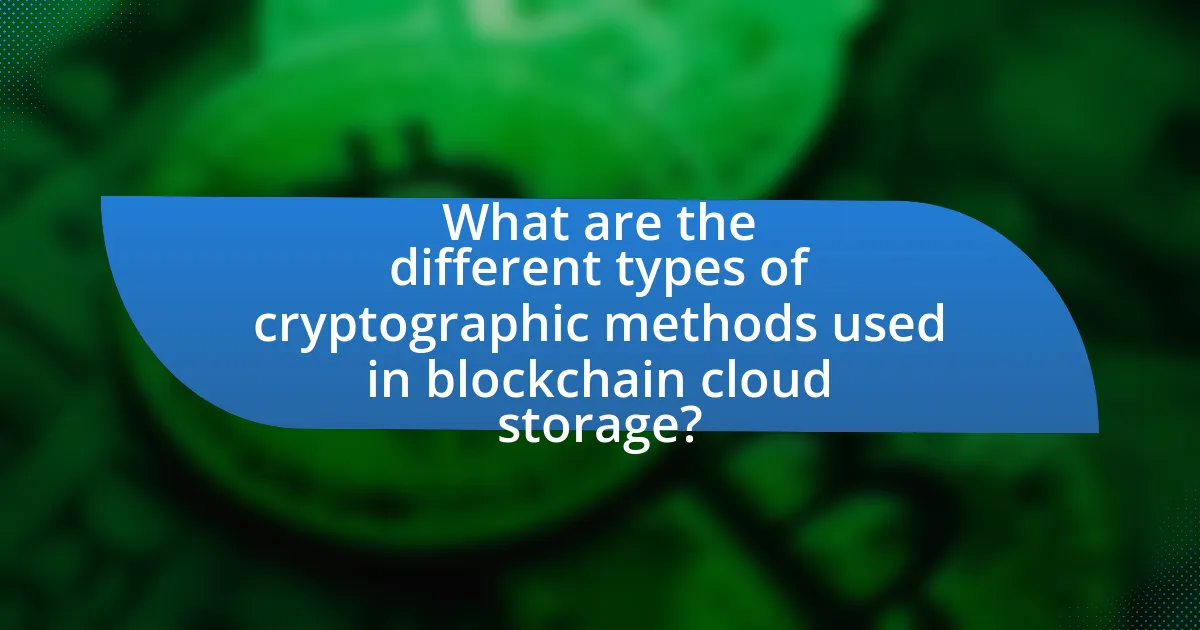Cryptography is essential for securing blockchain cloud storage, providing data integrity, confidentiality, and authentication through various techniques such as hashing, encryption, and digital signatures. Key cryptographic methods, including symmetric and asymmetric encryption, play a significant role in protecting sensitive information from unauthorized access and ensuring that data remains unaltered. The article explores how these cryptographic techniques enhance security, the vulnerabilities faced without them, and the implications for data privacy and regulatory compliance. Additionally, it outlines best practices for implementing cryptography effectively in blockchain cloud storage environments.

What is the Role of Cryptography in Securing Blockchain Cloud Storage?
Cryptography plays a crucial role in securing blockchain cloud storage by ensuring data integrity, confidentiality, and authentication. It employs techniques such as hashing, encryption, and digital signatures to protect sensitive information stored on the blockchain. For instance, hashing algorithms like SHA-256 create unique identifiers for data blocks, making it nearly impossible to alter the data without detection. Additionally, encryption methods safeguard data by converting it into unreadable formats, accessible only to authorized users with the correct decryption keys. Digital signatures further enhance security by verifying the identity of users and ensuring that transactions are legitimate. These cryptographic measures collectively fortify blockchain cloud storage against unauthorized access and data breaches, thereby maintaining trust and reliability in the system.
How does cryptography enhance security in blockchain cloud storage?
Cryptography enhances security in blockchain cloud storage by ensuring data confidentiality, integrity, and authenticity. Through techniques such as encryption, data is transformed into a secure format that can only be accessed by authorized users, preventing unauthorized access. Additionally, cryptographic hashing ensures that any alteration of data can be detected, maintaining data integrity. For instance, the use of SHA-256 hashing in Bitcoin ensures that any change in transaction data results in a completely different hash, alerting users to potential tampering. Furthermore, digital signatures authenticate the identity of users, ensuring that only legitimate parties can initiate transactions or access data. This combination of encryption, hashing, and digital signatures creates a robust security framework that protects sensitive information stored in blockchain cloud environments.
What are the key cryptographic techniques used in blockchain cloud storage?
The key cryptographic techniques used in blockchain cloud storage include hashing, public-key cryptography, and digital signatures. Hashing ensures data integrity by converting data into a fixed-size string of characters, which is unique to the original data; for example, SHA-256 is widely used in blockchain systems. Public-key cryptography enables secure data sharing and authentication, allowing users to encrypt data with a public key that can only be decrypted by the corresponding private key. Digital signatures provide authenticity and non-repudiation, ensuring that the data has not been altered and confirming the identity of the sender. These techniques collectively enhance the security and reliability of data stored in blockchain cloud environments.
How do these techniques protect data integrity and confidentiality?
Cryptographic techniques protect data integrity and confidentiality by employing algorithms that ensure data is both secure and unaltered during storage and transmission. For instance, hashing algorithms like SHA-256 create a unique digital fingerprint of data, allowing any unauthorized changes to be detected, thus maintaining integrity. Additionally, encryption methods such as AES (Advanced Encryption Standard) secure data by converting it into an unreadable format, ensuring that only authorized users with the correct decryption key can access the original information, thereby preserving confidentiality. These methods are foundational in blockchain cloud storage, where data integrity and confidentiality are paramount for user trust and system reliability.
Why is cryptography essential for blockchain cloud storage?
Cryptography is essential for blockchain cloud storage because it ensures data confidentiality, integrity, and authenticity. By employing cryptographic techniques such as encryption, data stored on the blockchain is protected from unauthorized access, making it unreadable to anyone without the appropriate decryption keys. Additionally, cryptographic hashing secures data integrity by creating unique digital signatures for each block, allowing users to verify that the data has not been altered. This is crucial in a decentralized environment where multiple parties interact, as it builds trust and accountability. The use of cryptography in blockchain cloud storage is supported by the fact that it underpins the security protocols of major blockchain platforms, such as Bitcoin and Ethereum, which rely on cryptographic algorithms to maintain the integrity and security of transactions.
What vulnerabilities does blockchain cloud storage face without cryptography?
Blockchain cloud storage faces significant vulnerabilities without cryptography, primarily including data exposure, unauthorized access, and integrity issues. Without cryptographic measures, sensitive data stored on the blockchain can be easily accessed by malicious actors, leading to potential data breaches. Unauthorized access occurs as there are no encryption protocols to safeguard user credentials or data, making it susceptible to hacking. Additionally, the integrity of the data is compromised, as there are no cryptographic hashes to verify that the data has not been altered or tampered with, which can result in misinformation or loss of trust in the system. These vulnerabilities highlight the critical role of cryptography in ensuring the security and reliability of blockchain cloud storage.
How does cryptography mitigate risks associated with data breaches?
Cryptography mitigates risks associated with data breaches by encrypting sensitive information, making it unreadable to unauthorized users. This encryption ensures that even if data is intercepted during transmission or accessed without permission, it remains secure and protected from exploitation. For instance, the Advanced Encryption Standard (AES) is widely used to secure data, providing a robust layer of protection that has been validated through extensive use in various industries. Additionally, cryptographic techniques such as hashing and digital signatures enhance data integrity and authenticity, further reducing the risk of unauthorized alterations or access.

What are the different types of cryptographic methods used in blockchain cloud storage?
The different types of cryptographic methods used in blockchain cloud storage include symmetric encryption, asymmetric encryption, hashing, and digital signatures. Symmetric encryption, such as AES (Advanced Encryption Standard), uses a single key for both encryption and decryption, ensuring data confidentiality. Asymmetric encryption, exemplified by RSA (Rivest-Shamir-Adleman), employs a pair of keys (public and private) for secure data exchange, enhancing security in transactions. Hashing algorithms like SHA-256 (Secure Hash Algorithm) create a fixed-size output from variable input data, ensuring data integrity by detecting any alterations. Digital signatures provide authentication and non-repudiation, allowing users to verify the origin of data and confirm that it has not been tampered with. These methods collectively enhance the security and reliability of data stored in blockchain cloud environments.
What is symmetric encryption and how is it applied in blockchain cloud storage?
Symmetric encryption is a cryptographic method where the same key is used for both encryption and decryption of data. In blockchain cloud storage, symmetric encryption is applied to secure sensitive information by encrypting data before it is stored on the blockchain, ensuring that only authorized users with the correct key can access the original data. This method enhances data confidentiality and integrity, as it prevents unauthorized access and tampering. For instance, platforms like Storj utilize symmetric encryption to protect user files, ensuring that even if the data is intercepted, it remains unreadable without the encryption key.
What are the advantages and disadvantages of symmetric encryption?
Symmetric encryption offers the advantage of speed and efficiency in encrypting and decrypting data, as it uses the same key for both processes, making it faster than asymmetric encryption. Additionally, symmetric encryption requires less computational power, which is beneficial for environments with limited resources, such as blockchain cloud storage systems. However, the primary disadvantage is the key management issue; if the key is compromised, all data encrypted with that key is at risk, leading to potential security breaches. Furthermore, symmetric encryption does not provide non-repudiation, meaning that it cannot verify the identity of the sender, which is crucial in many blockchain applications.
How does symmetric encryption compare to other methods in this context?
Symmetric encryption is generally faster and more efficient than asymmetric encryption in the context of securing blockchain cloud storage. This efficiency arises because symmetric encryption uses a single key for both encryption and decryption, which reduces computational overhead compared to asymmetric methods that rely on a pair of keys. For instance, symmetric algorithms like AES (Advanced Encryption Standard) can encrypt data at high speeds, making them suitable for large volumes of data typically stored in cloud environments. In contrast, asymmetric encryption, while providing enhanced security through key pairs, is slower and more resource-intensive, which can hinder performance in real-time applications. This distinction is crucial for blockchain cloud storage, where both speed and security are paramount for maintaining data integrity and accessibility.
What is asymmetric encryption and its role in blockchain cloud storage?
Asymmetric encryption is a cryptographic method that uses a pair of keys—one public and one private—to secure data. In blockchain cloud storage, asymmetric encryption plays a crucial role by ensuring that only authorized users can access or modify stored data, thereby enhancing security and privacy. This method allows users to share their public key for encryption while keeping their private key confidential, which prevents unauthorized access to sensitive information. The effectiveness of asymmetric encryption in blockchain is evidenced by its use in securing transactions and data integrity, as seen in platforms like Ethereum, where it underpins smart contracts and user authentication.
How does asymmetric encryption enhance user authentication?
Asymmetric encryption enhances user authentication by utilizing a pair of keys—public and private keys—that ensures secure identity verification. In this system, the public key is shared openly, while the private key remains confidential to the user. When a user attempts to authenticate, they can sign a message with their private key, and others can verify this signature using the corresponding public key, confirming the user’s identity without exposing sensitive information. This method significantly reduces the risk of impersonation and unauthorized access, as only the legitimate user possesses the private key necessary for authentication.
What are the challenges associated with asymmetric encryption?
The challenges associated with asymmetric encryption include key management, computational overhead, and vulnerability to certain attacks. Key management is complex because users must securely generate, store, and distribute their private keys, which, if compromised, can lead to unauthorized access. Computational overhead arises from the fact that asymmetric encryption algorithms, such as RSA, require more processing power and time compared to symmetric encryption, making them less efficient for large data sets. Additionally, asymmetric encryption is vulnerable to attacks like man-in-the-middle attacks, where an attacker can intercept and alter communications if they can impersonate one of the parties involved. These challenges highlight the need for robust key management practices and efficient algorithm implementations in the context of securing blockchain cloud storage.

How does cryptography ensure data privacy in blockchain cloud storage?
Cryptography ensures data privacy in blockchain cloud storage by employing encryption techniques that protect data from unauthorized access. Specifically, symmetric and asymmetric encryption methods are utilized to secure data both at rest and in transit, ensuring that only authorized users can decrypt and access the information. For instance, in blockchain systems, data is often hashed using cryptographic algorithms, which transforms the original data into a fixed-size string of characters, making it unreadable without the appropriate decryption key. This process not only secures individual data blocks but also maintains the integrity of the entire blockchain, as any alteration would be easily detectable. Furthermore, public key infrastructure (PKI) allows users to share their public keys for encryption while keeping their private keys confidential, enhancing security and privacy in cloud storage environments.
What are the implications of data privacy in cloud storage solutions?
Data privacy in cloud storage solutions significantly impacts user trust and regulatory compliance. When sensitive information is stored in the cloud, the risk of unauthorized access increases, necessitating robust encryption methods to protect data. For instance, a 2020 study by the International Association for Privacy Professionals found that 79% of consumers are concerned about their data privacy in cloud environments, highlighting the importance of implementing strong cryptographic measures. Additionally, regulations such as the General Data Protection Regulation (GDPR) impose strict requirements on data handling, making it essential for cloud providers to ensure data privacy to avoid hefty fines and legal repercussions.
How does cryptography protect user data from unauthorized access?
Cryptography protects user data from unauthorized access by transforming readable information into an unreadable format through encryption techniques. This process ensures that only authorized users with the correct decryption keys can access the original data. For instance, symmetric encryption uses the same key for both encryption and decryption, while asymmetric encryption employs a pair of keys—one public and one private. The use of strong algorithms, such as AES (Advanced Encryption Standard), provides a high level of security, making it computationally infeasible for unauthorized parties to decrypt the data without the key. Additionally, cryptographic methods like hashing ensure data integrity by producing a fixed-size output that uniquely represents the input data, allowing users to verify that the data has not been altered.
What role does encryption play in maintaining user anonymity?
Encryption is crucial for maintaining user anonymity by obscuring data and communications from unauthorized access. It ensures that only intended recipients can decrypt and access the information, thereby protecting user identities and activities from surveillance or interception. For instance, in blockchain cloud storage, encryption techniques like AES (Advanced Encryption Standard) are employed to secure user data, making it unreadable to anyone without the correct decryption key. This level of security is essential in preserving privacy, as it prevents third parties from linking data to specific users, thus maintaining their anonymity in digital transactions and interactions.
How does cryptography support regulatory compliance in blockchain cloud storage?
Cryptography supports regulatory compliance in blockchain cloud storage by ensuring data integrity, confidentiality, and authenticity. Through encryption, sensitive information is protected from unauthorized access, which aligns with regulations such as GDPR and HIPAA that mandate data protection. Additionally, cryptographic techniques like hashing verify that data has not been altered, fulfilling compliance requirements for data integrity. Furthermore, digital signatures authenticate the identity of users and transactions, ensuring accountability and traceability, which are essential for meeting regulatory standards. These mechanisms collectively reinforce the security framework necessary for adhering to legal obligations in data management.
What regulations require the use of cryptography in data storage?
Regulations that require the use of cryptography in data storage include the Health Insurance Portability and Accountability Act (HIPAA), the General Data Protection Regulation (GDPR), and the Payment Card Industry Data Security Standard (PCI DSS). HIPAA mandates the protection of sensitive patient information, necessitating encryption for data at rest and in transit. GDPR emphasizes the protection of personal data, requiring encryption as a safeguard against unauthorized access. PCI DSS outlines security measures for organizations handling credit card information, mandating encryption to protect cardholder data. These regulations collectively underscore the critical role of cryptography in ensuring data security and compliance across various sectors.
How can organizations ensure compliance through cryptographic measures?
Organizations can ensure compliance through cryptographic measures by implementing strong encryption protocols to protect sensitive data and maintain data integrity. By utilizing encryption standards such as AES (Advanced Encryption Standard) and RSA (Rivest-Shamir-Adleman), organizations can safeguard data both at rest and in transit, which is essential for meeting regulatory requirements like GDPR and HIPAA. Additionally, employing digital signatures and hash functions can verify the authenticity of data and ensure that it has not been altered, further supporting compliance efforts. These cryptographic techniques not only protect data but also provide audit trails that demonstrate adherence to compliance standards, thereby reinforcing the organization’s commitment to data security and regulatory obligations.
What best practices should be followed for implementing cryptography in blockchain cloud storage?
To implement cryptography effectively in blockchain cloud storage, organizations should follow best practices such as using strong encryption algorithms, ensuring key management is secure, and employing multi-factor authentication. Strong encryption algorithms like AES-256 provide robust data protection, while secure key management practices, including hardware security modules (HSMs), prevent unauthorized access to cryptographic keys. Multi-factor authentication adds an additional layer of security, making it harder for attackers to gain access to sensitive data. These practices are essential for maintaining data integrity and confidentiality in blockchain cloud storage environments.
How can organizations choose the right cryptographic techniques for their needs?
Organizations can choose the right cryptographic techniques by assessing their specific security requirements, regulatory compliance needs, and the sensitivity of the data they handle. They should evaluate the types of cryptographic algorithms available, such as symmetric and asymmetric encryption, and consider factors like performance, scalability, and ease of implementation. For instance, the National Institute of Standards and Technology (NIST) provides guidelines on cryptographic standards that can help organizations select appropriate techniques based on their risk assessments and operational contexts. Additionally, organizations should stay informed about emerging threats and advancements in cryptography to ensure their chosen methods remain effective over time.
What common pitfalls should be avoided when using cryptography in this context?
Common pitfalls to avoid when using cryptography in securing blockchain cloud storage include inadequate key management, reliance on outdated algorithms, and failure to implement proper access controls. Inadequate key management can lead to unauthorized access, as seen in cases where lost or compromised keys resulted in data breaches. Relying on outdated algorithms, such as SHA-1, exposes systems to vulnerabilities, as demonstrated by the successful collision attacks against this algorithm. Additionally, failing to implement proper access controls can allow unauthorized users to access sensitive data, which has been highlighted in numerous security incidents where weak access policies led to data leaks.


